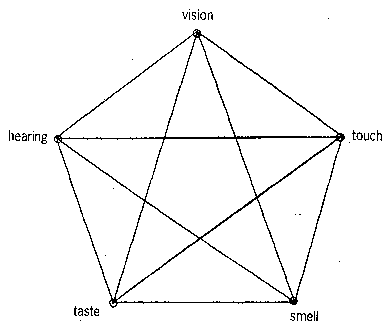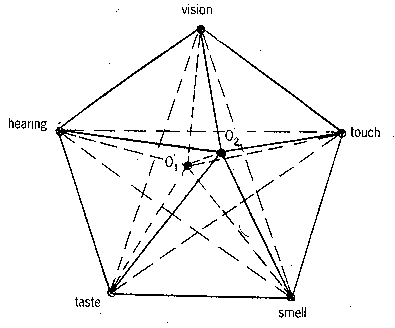The concept of synesthesia, as a psycho-physical phenomenon, can be
characterized briefly as intersensory, intersensual association. As I
have pointed out before, synesthesia is an essential sign of artistic
thinking (for all kinds of art, including
music) [1].
It should be particularly emphasized here that not only may exteroceptive
sensations (externally stimulated sensations such as hearing, sight, etc.)
act as components of synesthetic interrelationships (Fig.1), but
interoceptive and proprioceptive (internally generated) sensations may
also contribute. In Fig.2, points O1,
and O2 represent interoceptive and proprioceptive sensations,
respectively.
 Fig.1. Rough diagram of direct synesthetic ties
between external sensations.
Fig.1. Rough diagram of direct synesthetic ties
between external sensations.
The interoceptive receptors register the state of internal organs -
well-being, for instance - and proprioceptive sensations yield such
information as the position of the body in space (including muscular
and weight sensations). Interoceptive sensations act on the unconscious,
and they are tied to our most basic emotions. These sensations are
ancient and are part of the psychologies of all people-that is why
interoception-based synesthetic phenomena are the most powerful of al
emotional components. This is reflected in the broad usage of such
synesthetic terms as "bright" and "dark," in reference to sounds, and
"warm" and "cool," in reference to
colors [2].
In the past, investigators did not pay particular attention to the
importance of internal sensations in the original theories of synesthesia;
they generally limited themselves to studying more exotic exteroceptive
intersensory relationships (such as "color hearing" in music). However,
the presence of less noticeable, "dim" sensations (to use I.Sechenov's
term) determines more widespread intersensual relationships. When we
discuss audio synesthesias, such synesthesias are relationships between
"hearing" and proprioceptive sensations (point O2
in Fig. 2).
Fig.2. Detailed diagram of probable synesthetic ties
between external and internal sensations. Point 01
designates interoceptive sensations, and point 02
designates proprioceptive sensations. Here it can be seen that, in
addition to the direct routes shown in Fig. 1, external sensations can
be reached through internal ones.
Analogies between melody and mechanical motion are tied to the above-mentioned
audio-proprioceptive synesthesias. These analogies may be quite interesting
- for instance, theories on the "kinetic energy" of sound, by
E. Kurt [3];
on "sound body" and "sounding matter,"
by B. Asafiev [4];
and, especially, on "audio space," by G. Revesh, A. Weliek and
E. Nazaikinsky [5].
Audio space may even have its own coordinates: depth (texture), vertical
(melodies), horizontal (architectonics of music pieces as a whole).
In my opinion, the study of another, still hypothetical synesthetic
analogy-between perception of terrestrial gravity) and modal gravity in
music (suggested as far back as the 1920s by
B.L. Yavorsky) [6])
can help to deepen comprehension of the nature of the audio space in
which the sound body moves. The analogy has remained a hypothesis until
now because its proof has been impossible for traditional musicologists
and psycho-physiologists, who have separately tried to determine its
validity. It can be recalled that modal organization is the most specific
characteristic of music, sharply distinguishing it from the other arts.
Modal organization in music, along with humans' psychological ability
to react to sound independently, is responsible for the phenomenon
of melody - combining sequences of single sounds into integral
sound configurations, which act in the perceived audio space. Let us
compare such peculiarities of hearing with human vestibular apparatus
functions that give information about a person's position and
motion in space in response to Earth's gravitational field and
acceleration.
Yavorsky believes that regular shifting between various forms of balance
(stability) and imbalance (instability) in music is the key to understanding
the psychophysiological bases of different constructions in art. It is
well known that gravity shows its worth in all kinds of art - in
painting and in architecture (compositional balance), in
choreography (with its art-linguistic structures built by a continual
fight against gravity in general).
In music, analogously, the propensity of imbalance to resolve into
balance has basic significance in musical dynamics, namely for "mode
building," where modes are thought by Yavorsky to be a sum total of
gravitational pulls on the unbalanced sounds, resolving them into
balanced ones [7].
Yavorsky uses the concept of audiogravity to explain other musical
characteristics as well. He defines the sense of rhythm as the ability
to orient oneself in time and within the earth's gravitational
force. He writes:
"Breaking down the sense of gravity is a matter of being aware of its presence and
mastering it as a force of nature. The process of breaking down and detecting gravity
results in rhythm. . . This rhythmic process of conquering the sensation of gravity, which
was revealed with sound and perceived through sound, is the genuine birth of music. . . .
The process of realizing gravity, mastering it as an organizing power, is rhythm, which
gives shape to the sensation of gravity and its mode; together they form "modal
rhythm," which is the essence of musical
language" [8].
Modal rhythm characterizes the process of modal development unfolding
in time. Timbre and dynamics emphasize and accentuate the bounds of
gravity, and tempo emphasizes the rate of change of these bounds,
according to Yavorsky.
Yavorsky's gravitational analogies, as they relate to separate modes,
are of particular interest here. He compares the aspiration of "being
in a natural major" with the human propensity to stand upright, but,
based on the fact that humans can function when they are in other
positions, Yavorsky supports the active development of new musical
methods as well.
Yavorsky compares "twice-modes" (his term), which occur when imbalance
has a double resolution, both inward and outward, as in the easy
soaring of an airplane when the opposite forces acting upon it are
equalized [9].
Based upon all these analogies, Yavorsky's hypothesis can be supplemented.
The evolution of music has involved, to a certain extent, the apparent
slackening of mode-functional relationships, which, within limits, has
resulted in atonality, involving the aspiration of all the tones for
complete equality of their rights, and liquidation of whatever tonal
center and gravitational pulls exist among them. Is it possible that
this evolution of mode in music is a peculiar audio model? Or is it a
subconscious and synchronous synesthetic reflection of the natural
evolution of ideas relating to the possibility of overcoming Earth's
gravitational forces?
This supposition and the initial hypothesis by Yavorsky can be examined
with a very simple experiment. It is known that during space flight one's
vestibular apparatus stops feeling the influence of gravitational forces.
If, under terrestrial conditions and against a background of powerful
gravitational force, the uncomfortable influence of unbalanced sound
relationships (dissonant chords or intervals) displays itself to people
with keen hearing, it is quite possible that the influence of music
would, in the state of zero gravity, provoke noticeably negative emotions.
Astronauts on board spaceships should be given appropriate musical
programs to listen to, and objective parameters characterizing the state
of their vestibular systems should be measured while they are listening.
If differences were detected in the "gravitative-compensative" effect
in the perception of, for instance, Bach's tonal music and Shoenberg's
atonal music, it could serve as an indirect corroboration of Yavorsky's
analogy: "terrestrial, Earth gravity = audio, modal gravity in music."
I propose an experiment in which NASA pilots would take two audiotapes
on the next Space Shuttle flight. Tonal music would be on the first tape,
and atonal music would be on the second tape - the effects of these
recordings on the psyches of the pilots would be investigated. I
predict that tonal music will provide compensation for negative effects
caused by the transition to a zero-gravity state. I also predict that
listening to the atonal music will deepen these negative effects.
If these theories of synesthetically mediated reception of gravity in
music turn out to be true, it will affect our understanding of the
nature of music. In addition, the results would be useful for quite
utilitarian ends - for the creation of special compensative-musical
programs to aid in the adaptation to the state of weightlessness.
References and Notes:
- B.M. Galeyev, Man, Art and Technology:
Problem of Synesthesia in Art (in Russian) (Kazan, Russia: Kazan Univ.
Publishers, 1987) pp.254-263.
- Galeyev [1] pp.101-103. This monograph
contains references to works written by psychologists, such as
A.R. Luria, B.M. Velichkovsky and V.S. Raitses, who investigated
interoceptive sensations and their interrelations.
- E. Kurt, Romantische Harmonik und ihre in
Wagner's Tristan (in Russian) (Berlin: 1923); E. Kurt, Grundlagen des
linemen Kontrapunkts. Bach mehdischer Polyphonie (Bern: 1917).
- Glebov (B. Asasfiev's pseudonym), "The
Process of Shaping of Sound Materials," in De Musica, compiled works
(in Russian) (St. Petersburg: 1923) pp.144-164.
- E.O. Nazaikinsky, Ore Music Perception
Psychology (in Russian) (Moscow: Muzyka Publishers, 1972) pp.86-185.
- B.L. Yavorsky, "Basic Elements of Music,"
(in Russian) Iskusstvo 1 (1923) pp.185-194.
- V.A. Tsukkerman, "Mode Rhythm," Music
Encyclopedia Vol.3 (in Russian) (Moscow: 1976) pp.143-145.
- See Yavorsky [6].
- B.L. Yavorsky, Articles, Memoires,
Correspondence, Vol. 1 (in Russian) (Moscow: Sovjetsky Kompozitor
Publishers, 1972) p.711.
Published in "Leonardo", vol. 26, 1993, N 1, pp.76-78).

